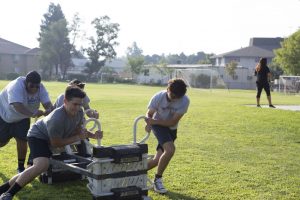This is a blog for students and adults who want to ponder the benefits of exercise, fitness and strength training and their implications for life beyond the momentary endorphin rush or the pursuit of some physical aesthetic ideal. The views and opinions expressed in this blog are founded on several years of personal experience, observation, trial and error (lots of the latter) and study. This is the second of a biweekly series of blogs written by Mick Fuller. To read the first post in this series read: Functional Human blog, No. 1.
Do you exercise or do you train? That question addresses crucial differences in value and purpose for the way we approach our workouts. To answer the question it will be helpful to understand the distinguishing features of training and exercise and examine how these concepts are related. This post will mostly be about defining terms, in order to be very clear in in framing our answer to the question at hand.

Training involves performance of repeatable patterns of movement that produce sufficient muscular and neurological stress to initiate the body’s recovery and adaptation systems. Each training session is calibrated to be more stressful than the previous session, to account for the body’s recovered and adapted state.
That means a training program must involve frequent and consistent performance of the same movements at incrementally higher levels of intensity in order to drive continuous improvement over an extended period of time.
The context for this post is physical training for strength or endurance, but the concept may be applied to any type of development program that pursues continuous improvement as a primary outcome. People engage in athletic skill training, computer training, job training, memory training, and on and on.
Exercise is what we do when we move our bodies either fast enough or long enough to produce an elevated heart rate, increased core body temperature and increased rate of respiration with (or without) the intent of improving health. Exercise occurs when we play a pick-up basketball game, go for a hike or jog, use the weight machines or barbells at the gym and an infinite list of other activities. (Many everyday activities we perform but do not associate with exercise, such sweeping the walk with a push-broom and climbing a ladder to clean the gutters can produce the same physiologic responses.)
The hallmark of exercise is that we perceive an immediate difference between our body’s homeostasis (resting/steady state) and the stimulated state of faster heartbeat, heavier breathing and feeling hot/perspiring, and possibly feeling a lower energy level and reduced work capacity which we interpret as “tiredness” or “exhaustion.”
The change is immediate, but the effects diminish and disappear quickly once the activity ceases, the body replenishes energy stores and returns to homeostasis. A discrete bout of exercise may be (and frequently is) intense enough to trigger the stress recovery adaptation cycle. If that occurs, the new homeostasis will represent a slightly enhanced level of physical fitness.

The key to understanding the differences between exercise and training lies in recognizing the systematic long term nature of training as opposed to the isolated, episodic and often variable nature of exercise. Within the context of a single training session, the the trainee will perform a set of movements according to a plan that stipulates factors such as intensity, duration, volume of work, etc.
A series of training bouts will, if they are performed at appropriate intervals with incrementally increasing levels of stress, produce long term changes to the various body systems targeted by the training plan. The systematic quality is the same for all types of training, whether the focus is on strength or endurance or skill development. Programming parameters such as selection of movements or activities and frequency of the training will correspond to the trainee’s long term goals.
In contrast to a systematic approach, exercise as defined above, no matter how frequent, will not result in significant lasting effects if the amount of stress per session does not consistently disrupt the body’s homeostasis and stimulate the stress recovery adaptation cycle.
There is nothing wrong with exercise. On the contrary, it is a good thing and there is benefit in frequent or even occasional bouts of moderate physical activity that elevates the heart rate for a sustained period. It must be understood, however, that improvements in strength, work capacity (in various energy systems), endurance and skill only occur as the result of a systematic approach in which more work is performed or greater loads are used each session.
This brings us back to the initial question of whether we train or exercise. Now that we know what the terms mean it should be a simple matter to determine what we do. However, with that initial question answered, we now face deeper questions: why we do what we do and what should we do and how do those reasons relate to our progress in becoming more functional humans. But those are questions for another day.
To read the first post in this series, read: Functional Human blog post, No. 1.







Carson • Sep 26, 2018 at 11:26 am
This is a fantastic article!
Mackenzie Beckworth • Sep 26, 2018 at 10:38 am
Loved this (:
Riley Goldsborough • Sep 26, 2018 at 8:20 am
I really need to work out more.
Vickey • Sep 25, 2018 at 11:28 am
Great information!